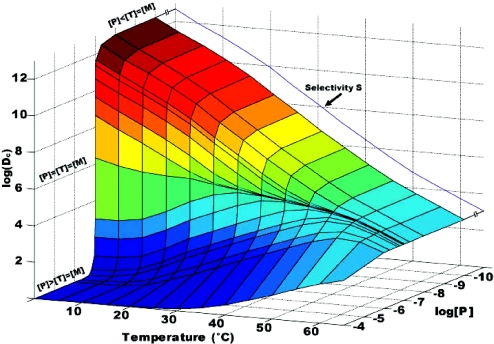Figure 4.
Discrimination, Dci, (Equation 8) was calculated for the system of three oligonucleotides undergoing competitive hybridization with one another. Two oligonucleotides T = TCTTAATCATACCTTC and M = CACTCTATCAATCATA compete for hybridization to P = GAAGGTATGATTAAGA. The oligonucleotide P is perfectly complementary to T and forms a mismatched duplex with M. In this example, [T] = [M] = 1 × 10−7 M and [P] varies between 10−4 M and 10−10 M. Free energy calculations were performed with the assumption that hybridizations would be performed in 1 M NaCl. For reference, the temperature dependent selectivity, S, is shown as the blue line and is highlighted with an arrow. Discrimination, Dci, is highest (approaching the maximum selectivity) when P is the limiting reagent ([P] < [T] = [M]) and lowest when P is present in excess ([P] > [T] = [M]). Any P that is not consumed in a reaction with T will be available to react with M and form the mismatched duplex, MP. This is the reason for the low discrimination.

